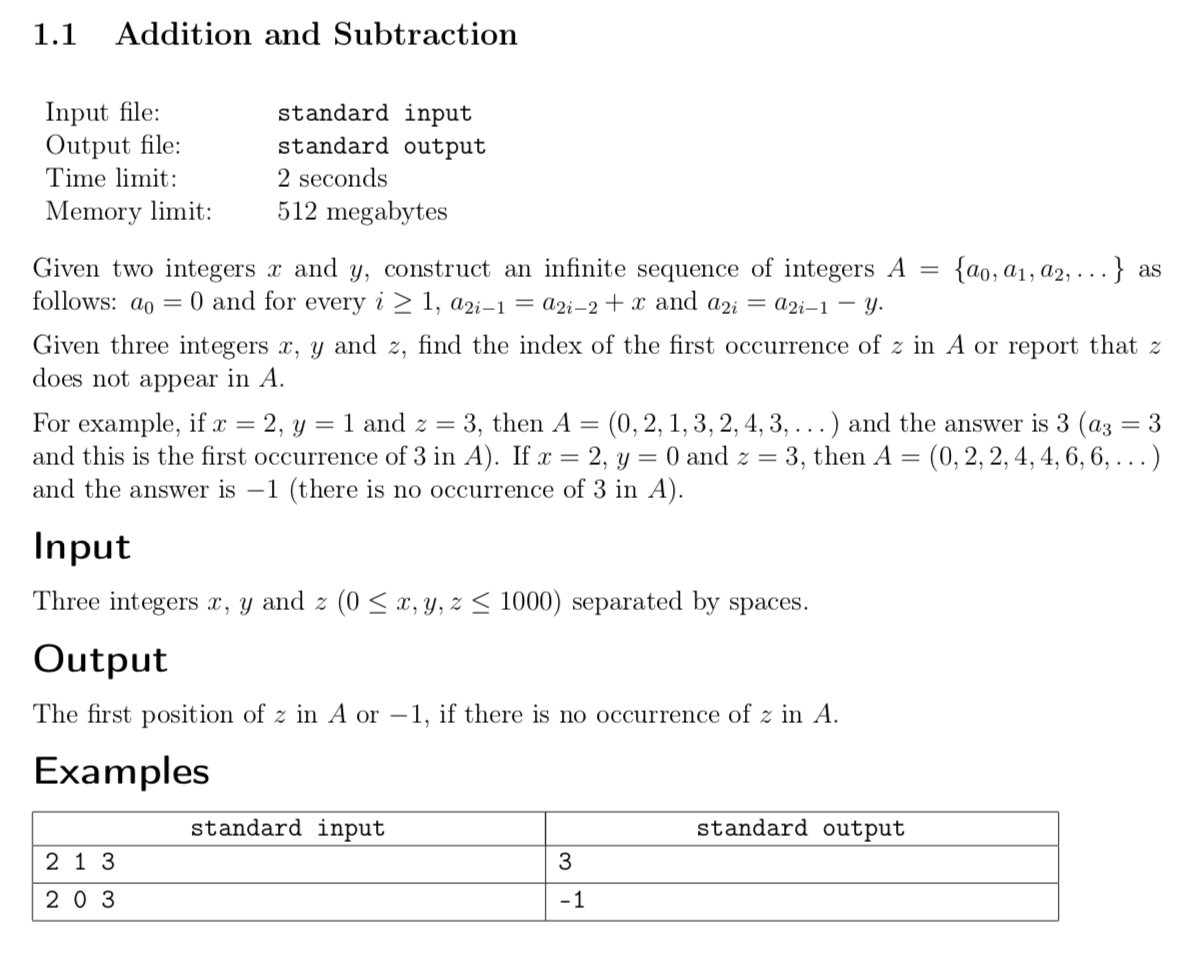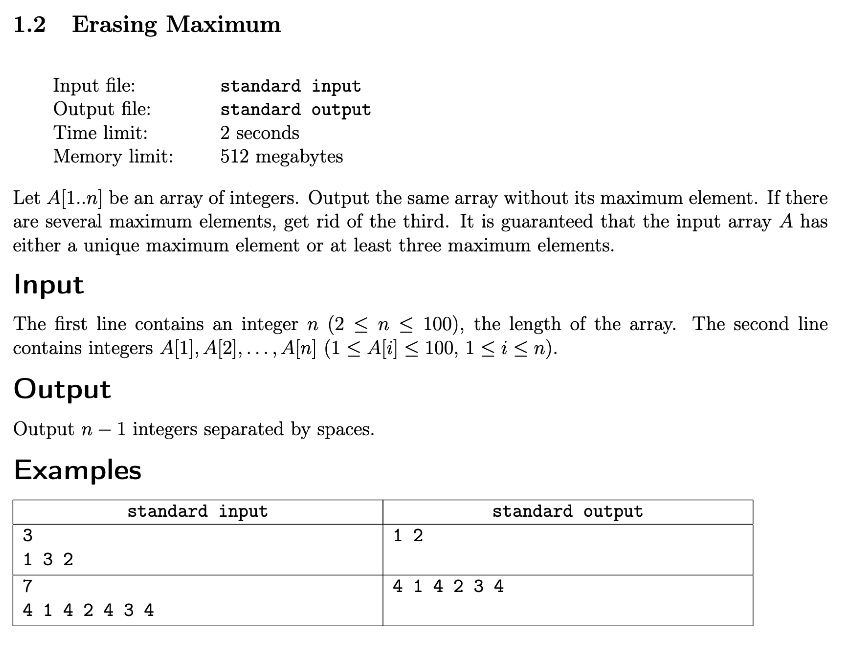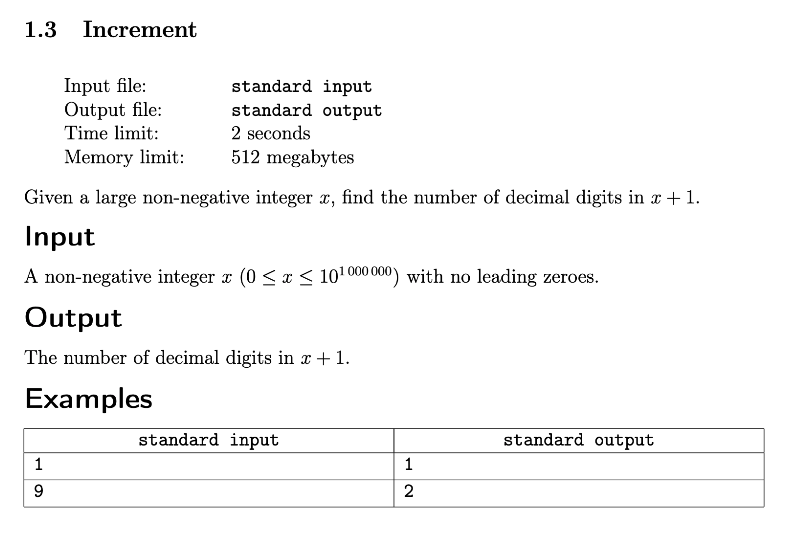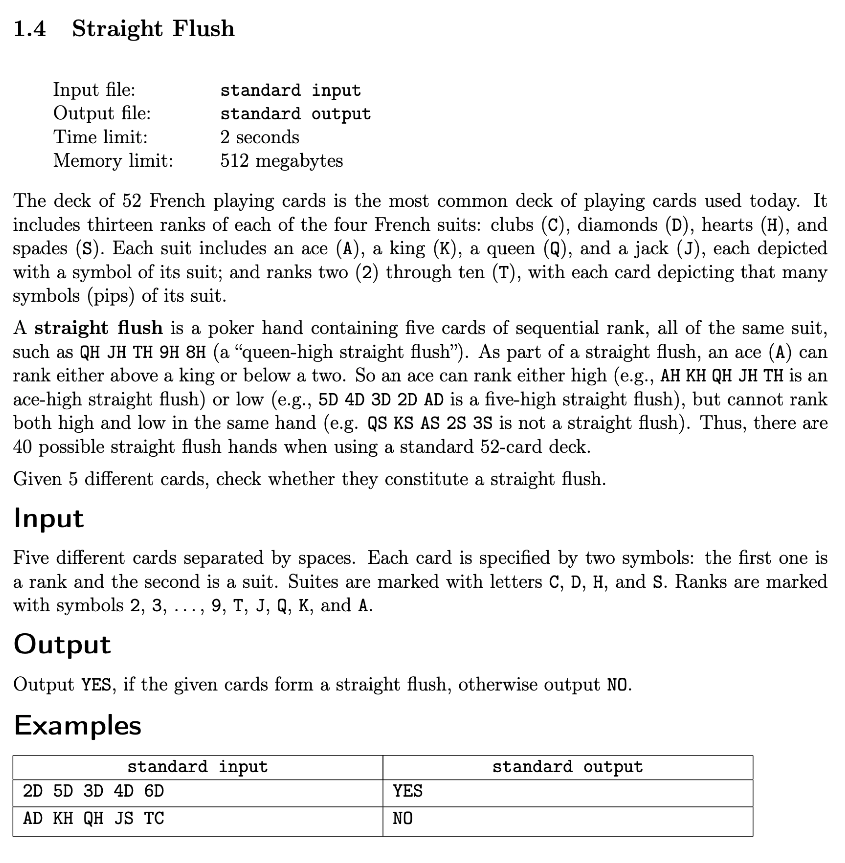competitive-programming
Competitive Programmer's Core Skills by Saint Petersburg State University
Project maintained by claytonjwong Hosted on GitHub Pages — Theme by mattgraham
Week 1: Programming Competitions
Key Concepts
- Know various strategies for inventing test cases and testing programs
- Understand what programming competitions and algorithmic problems are, what’s the difference compared to other forms of programming
- Learn about various platforms dedicated to competitive programming, and what opportunities they offer
Resources
Assignments
Inventing Tests
- Problem 1: You are given a non-empty list of integers, and you need to find the maximum value among them. The length of the list is not greater than 100, and the absolute value of each element is not greater than 1000.
def solve(a):
max = 0
for x in a:
if x > max:
max = x
return max
- Test 1: Implement a function called getTest. It should return a list on which the solve function works incorrectly.
def getTest():
return [-1, -2, -3]
- Problem 2: You are given a non-empty list of integers. Find the maximum possible value which could be obtained as the sum of no more than two elements from the list. You can’t take the same element twice, but you could take two distinct elements which are equal by value. The length of the list is not greater than 100, each element is positive and not greater than 1000.
def solve(a):
max = 0
for i in range(len(a)):
for j in range(len(a)):
if i != j and a[i] + a[j] > max:
max = a[i] + a[j]
return max
- Test 2: Implement a function called getTest. It should return a list on which the solve function works incorrectly.
def getTest():
return [-1]
- Problem 3: Given an integer N, find how many pairs of distinct integers from 0 to N - 1 sum up to an even value. (1, 2) and (2, 1) are the same pair. N is positive, and doesn’t exceed 100000.
def solve(n):
ans = 0
for i in range(n):
for j in range(n):
if i < j and (i + j) % 2 == 0:
ans += 1
return ans
- Test 3: Implement a function called getTest. It should return a list on which the solve function works incorrectly.
def getTest():
return 100000
- Problem 4: You are given a string of lowercase English letters. First, remove all occurrences of its first letter, e.g. “abacaba” -> “bcb”. Then, return the longest prefix of the remaining string which doesn’t contain two different letters. The initial string is at least 5 and no more than 100000 characters long.
def solve(s):
toDelete = s[0]
others = ""
for c in s:
if c != toDelete:
others += c
s = others
#prefix of length 1 surely doesn't contain different letters
prefix = s[0]
for i in range(1, len(s)):
#each letter should be the same as the first
if s[i] == prefix[0]:
prefix += s[i]
else:
break
return prefix
- Test 4: Implement a function called getTest. It should return a list on which the solve function works incorrectly.
def getTest():
return "aaaaa"
Addition and Subtraction

#include <iostream>
using namespace std;
int N = 2 * 1000; // 2 ops (add/sub) result in minimum "helpful" delta of 1 (ie. go 1 step closer to max target 1000)
int main() {
auto add{ 0 }, sub{ 0 }, target{ 0 }, ans{ -1 };
cin >> add >> sub >> target;
for (auto i{ 0 }, x{ 0 }; i <= N; ++i) {
if (x == target) {
ans = i;
break;
}
x += i % 2 == 0 ? add : -sub;
}
cout << ans << endl;
return 0;
}
Erasing Maximum

#include <iostream>
#include <vector>
#include <algorithm>
#include <iterator>
using namespace std;
int main() {
int N{ 0 }, del{ -1 };
vector<int> A;
cin >> N, copy_n(istream_iterator<int>(cin), N, back_inserter(A));
for (auto i{ 0 }, max{ 0 }, cnt{ 0 }; i < N; ++i) {
if (max < A[i])
max = A[i], cnt = 0, del = i;
if (max == A[i] && ++cnt == 3)
del = i;
}
A.erase(A.begin() + del);
copy(A.begin(), A.end(), ostream_iterator<int>(cout, " ")), cout << endl;
return 0;
}
Increment

#include <iostream>
#include <algorithm>
using namespace std;
int main() {
string S; cin >> S;
auto N = all_of(S.begin(), S.end(), [](auto c) { return c == '9'; }) ? S.size() + 1 : S.size();
cout << N << endl;
return 0;
}
Straight Flush

#include <iostream>
#include <vector>
#include <algorithm>
#include <iterator>
#include <unordered_set>
#include <cassert>
using namespace std;
int main() {
int N{ 5 };
vector<string> A; copy_n(istream_iterator<string>(cin), N, back_inserter(A));
auto isSameSuit = [&](unordered_set<char> S = {}) {
transform(A.begin(), A.end(), inserter(S, S.end()), [](auto& card) { return card[1]; });
return S.size() == 1;
};
auto getValues = [&](bool aceHigh, vector<int> V = {}) {
transform(A.begin(), A.end(), back_inserter(V), [=](auto& card) {
auto val = card[0];
if (isalpha(val)) {
switch (val) {
case 'A': return aceHigh ? 14 : 1;
case 'K': return 13;
case 'Q': return 12;
case 'J': return 11;
case 'T': return 10;
}
}
return val - '0';
});
return V;
};
auto isStraight = [=](auto& values) {
assert(N == values.size());
return N == 1 + *max_element(values.begin(), values.end()) // +1 for [i..j] inclusive
- *min_element(values.begin(), values.end());
};
auto hi = getValues(true), // ace high
lo = getValues(false); // ace low
cout << (isSameSuit() && (isStraight(hi) || isStraight(lo)) ? "YES" : "NO") << endl;
return 0;
}